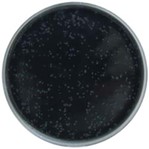Campylobacter Blood Free Selective Agar (CCDA) Detail
One of several media formulations available for the selective isolation of Campylobacter spp., primarily C.jejuni and C.coli, which are the leading cause of enteric illness in the UK. Campylobacter spp. can cause mild to severe diarrhoea, usually self-limiting, but some specific serotypes can trigger acute post-infective conditions affecting the peripheral nervous system, such as Guillain-Barré Syndrome. Campylobacter Blood-Free Selective Medium (CCDA) was first described by Bolton. This medium was formulated to replace blood with a combination of charcoal, ferrous sulphate, and sodium pyruvate. Also, to improve selectivity, Cefoperazone replaced the Cephazolin utilised in the original formulation. Bolton recommended incubating inoculated plates at 37°C to improve isolation rates but incubation at 41.5°C is recommended for the isolation of the commonly encountered thermophilic species (C.jejuni & C.coli). Yeast and fungal contaminants can be suppressed with the addition of Amphotericin B. Campylobacter Blood-Free Selective Medium (CCDA) is recommended for food testing. Campylobacter Blood-Free Selective Medium with the addition of Yeast Extract and Cefoperazone is used in the Isolation of Campylobacter species from foodstuffs and swabs in the FDA/BAM Method.
Campylobacter Blood Free Selective Agar (CCDA) P0011
- Category: Clinical & Veterinary
- Pack Size: 10 x 90 mm plates
- Shelf Life: 12 weeks
- Storage Temp: 2-8 °C
- Appearance: Firm Gel
- Colour: Charcoal
- Recommended Incubation: 41.5 ± 1°C for 44 ± 4 hours
- pH: 7.4 ± 0.2
- Fill Volume: 20.0 ± 2.0ml
Quality Control
| Organisms | Ref. No | Result |
|---|---|---|
| Campylobacter jejuni | ATCC® 33291 | Good growth, grey coloured colonies |
| Escherichia coli | ATCC® 25922 | Total or partial inhibition |
| Staphylococcus aureus | ATCC® 25923 | No growth |

